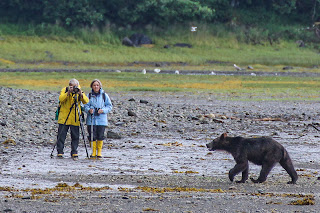The introduction to the permit for the bear viewing area reads, "Pack Creek is part of the Kootznoowoo Wilderness and visitors face inherent risks from adverse weather conditions, isolation, physical hazards, and lack of real time communications. Remember that the weather in Southeast Alaska is often poor and always unpredictable. Flights are sometimes cancelled due to high winds and poor visibility. [It is a] Wilderness Area and has no facilities on site, including no dock, no bathrooms, no shelter from the elements (except an Observation Tower) and no cell phone service. Access to and traveling within the bear viewing area requires getting your feet wet; rubber boots are highly recommended. Bring rain gear and extra layers, even if the weather seems to be nice. The weather can turn cold and rainy at any time of the year in southeast Alaska."
Yes, we know all about SE Alaskan weather! It rained all day Sunday. We tried to go out in the dinghy between showers. However, the "between" was not very long.
The rain stopped Monday morning. We arrived at the park just after it opened at 9 AM. Leah, a ranger, greeted us, took our permit, and gave us an orientation. "All food, including gum and candy must be stored in those bear-proof containers. Food may only be consumed between these two beach rocks. Women will find toilet privacy behind those two rocks. Keep on the trails. The bears are used to people. If you see a bear, stop and let the bear decide how to proceed."
| ||
| ||
|
Junior is a 2.5-year old subadullt (read "teenager"). An adult male grizzly may have spooked him; adult males are known to eat the young bears. Later, we saw Junior with his friend Cino (as in Cappuccino, the daughter of Mocha!) They became acquainted when they were cubs. Cino is a year older and has been on her own for a year. This is Junior's first year on his own. They nuzzled noses and frolicked. Then began foraging together.
 |
| Mocha and Cocoa |
 |
| Cocoa Cuddling Mocha |
| ||
| ||
|
Stan Price and his wife had a homestead in Pack Creek from the mid 1950's until the late 1980's. They raised several orphaned bear cubs, who stayed in the area and returned later with their own cubs. This was the start of the habituation of the bears to people. However, the strict rules regarding food prevents the bears from associating people with food. A total of 95 square miles on Admiralty Island is protected habitat for grizzly bears.
Grizzly cubs are with their mothers for 2 to 3 years. Subadult siblings may stay together for an additional couple of years. They mate at about 7 or 8. Females may live to be 30 years old; males live to 20.
Nancy told us lots of stories and answered a string of questions. She had an encounter with mom and cub, where the mom lay down for a snooze near the viewing area and the cub was curious about Nancy. Nancy glared back at the cub but he didn't move. Finally, mom got between Nancy and the cub. She thinks that the mom had taught her cub that people were not dangerous in the viewing area, but had yet to teach him to keep his distance.
At the end of the day, we had seen about ten bears, had great conversations, had sun warm enough to take off all but the last layer, and enough rain to get the umbrella for Urs's camera wet. After 10.5 hours in the park, we were about to leave, when a mother with two cubs arrived. We watched another 5 minutes and left before it got dark. Very nice day.
|
| |||||
|










How do you ascertain if *all* the bears are used to people?
ReplyDeleteCan you tell me a little about the reservation process? Did you have to really plan ahead (like Glacier Bay) or were you able to show up at the ranger station and make a reservation then? Cheers! Stephanie
ReplyDeleteCan you tell me a little about the reservation process? Did you have to really plan ahead (like Glacier Bay) or were you able to show up at the ranger station and make a reservation then? Cheers! Stephanie
ReplyDelete